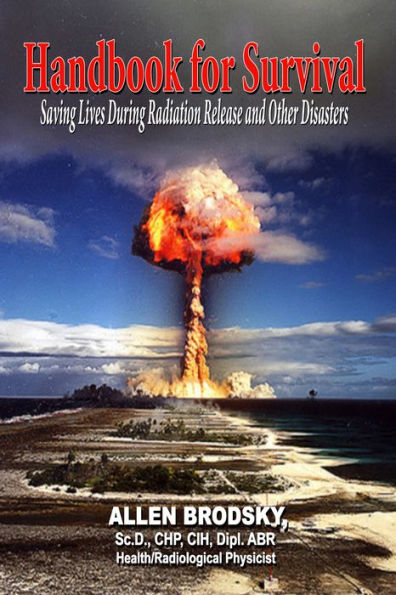
Handbook for Survival: Saving Lives During Radiation Release and Other Disasters

Handbook for Survival: Saving Lives During Radiation Release and Other Disasters
Overview
This is Dr. Brodsky’s 9th book with data and information for protecting health and saving lives. It condenses his 2011 book, Action for Survival, into life-saving information easily followed by any member of the public. The urgency for distributing this information now, as indicated here in the few pages of Appendix C, is supported by the following quote from a paragraph in the book by former Secretary of State Colin Powell, My American Journey:
“…sanctions work best against leaders who have the interests of their country and people at heart, because sanctions hurt the people and the country more than the leaders…And since these leaders are still going to have a roof over their heads, food on their tables, gas in their tanks, and power in their hands, sanctions rarely work against them…”
Information here in Dr. Brodsky’s book (see his background at the end of the book) fills gaps in official homeland security preparations and will empower civilians to save their own families, not only from radiation but also from other natural disasters or terrorist events.
ABOUT THE AUTHOR: Dr. Allen Brodsky has a B.E. in chemical engineering from The Johns Hopkins University, an Atomic Energy Commission-National Research Council (AEC-NRC) Fellowship in Radiological Physics at the Oak Ridge National Laboratory, a masters in physics, and a doctor in science (Sc.D.) in biostatistics and radiation health, University of Pittsburgh. He is certified by the American Board of Health Physics, the American Board of Industrial Hygiene, and the American Board of Radiology.

Product Details
| BN ID: | 2940046101416 |
|---|---|
| Publisher: | Allen Brodsky |
| Publication date: | 08/06/2014 |
| Sold by: | Smashwords |
| Format: | eBook |
| File size: | 2 MB |
About the Author
Dr. Allen Brodsky retired from full-time employment in 1986 but still mentors graduate students in their internships as an Adjunct (part-time) Professor of Radiation Science at Georgetown University. He also occasionally consults on radiation safety issues, but spends most of the time writing articles and books based on information accumulated during his 62-year career since completing college. The majority of his career has been in the fields called “health physics” and “medical physics.” In the field of health physics, his research, practice, and teaching has been related to: developing procedures and engineered facilities for protecting the health of workers and the public from harmful amounts of radiation; and writing necessary but reasonable safety regulations and guides so that our society can safely enjoy the benefits of radiation and radioisotope applications, in such practices as nuclear medicine diagnostics, radiation therapy, and industrial products that benefit humankind. In the field of medical physics, he developed methods of administering radiation for cancer therapy, and published procedural and staffing requirements for hospitals and medical institutions to ensure safe applications of radioactive material in diagnosis, therapy, and research.
His education includes a bachelor’s degree in chemical engineering and master’s in physics from Johns Hopkins, and a doctorate in biostatistics and radiation health from the University of Pittsburgh. He also had a one-year graduate fellowship in Radiological Physics at Oak Ridge National Laboratory (1949-50), and is certified by the American Boards of Health Physics, Industrial Hygiene, and Radiology.
His employment positions included Head, Health Physics Unit, Naval Research Laboratory; Physicist on Operations Ivy and Castle (first two H-bomb tests); Physicist in the Federal Civil Defense Administration; Health Physicist in the Atomic Energy Commission; Associate Professor in the Graduate School of Public Health, University of Pittsburgh; Radiation Physicist, Mercy Hospital, Pittsburgh; Adjunct Research Professor, Duquesne University School of Pharmacy; Health Physicist, U.S. Nuclear Regulatory Commission; Senior Scientist at SAIC performing radiation dose assessments of veterans exposed to fallout from atomic tests (retired from over 8 years full-time in this position in 1997 to March 2006); and Adjunct Professor of Radiation Science, Georgetown University (1987 to present). In addition, he has consulted for a variety of medical institutions, industrial facilities, and government research committees, and reviewed research proposals for four government agencies.
He has many publications and his books include: Information for Controlling Radiation Emergencies, 1960, Atomic Energy Commission; CRC Handbooks of Radiation Measurement and Protection, Volumes I-IV, 1978-86, editor and contributor of many chapters; Review of Radiation Risks and Uranium Toxicity, 1996, RSA Publications; and Public Protection from Nuclear, Chemical, and Biological Terrorism, 2004, Medical Physics Publishing, Editor and author of nine chapters and appendices (a chapter summarizing his management and evaluation of radiation accidents can be reviewed on www.medicalphysics.org). This is his eighth book published commercially. Living with Insomnia, co-authored with his wife, Phyllis, was recently published by McFarland and Company, Inc., 2011.
His work is summarized in Who’s Who in the World and other library biographical references. His awards for research, teaching, and service include: the Founder’s Award (1986), Fellow Award (1992), and the Robley D. Evans Medal (2001) of the Health Physics Society; the 1986 Failla Memorial Lecturer Award of the Greater New York Chapter of the Health Physics Society and the Radiological and Medical Physics Society; the Radiation Science and Technology Award (1993) of the American Nuclear Society; the Distinguished Graduate Award (2004) of the Graduate School of Public Health, University of Pittsburgh; and the Vicennial Medal of Georgetown University (2006).
*I must admit that I wrote this myself. Due to lack of space I included only successful experiences and awards; listing my mistakes and failures would have required too many pages.
